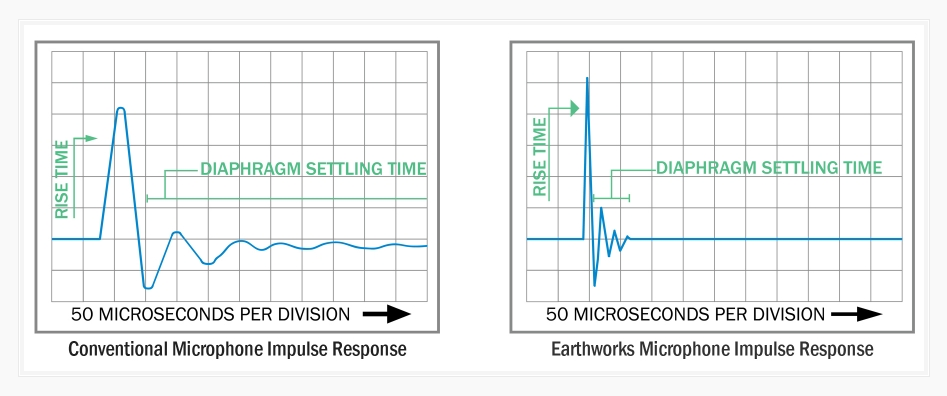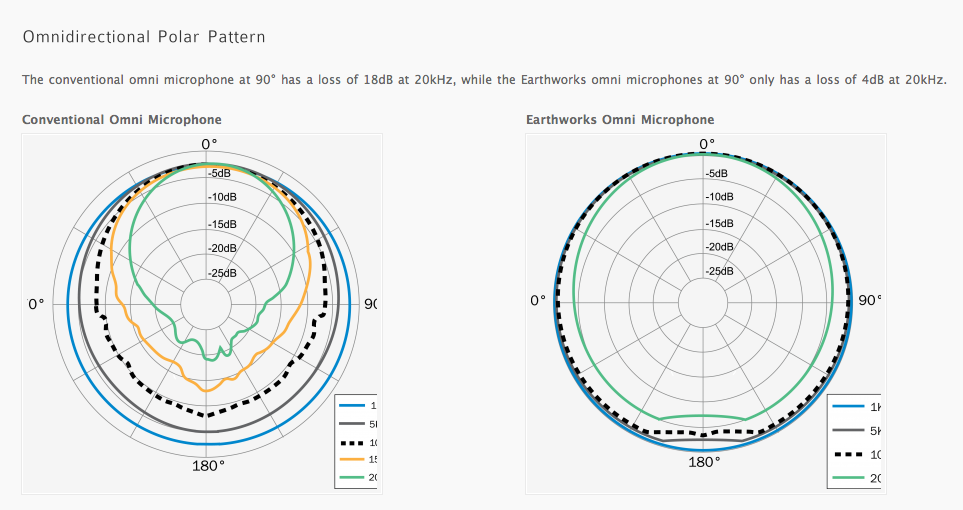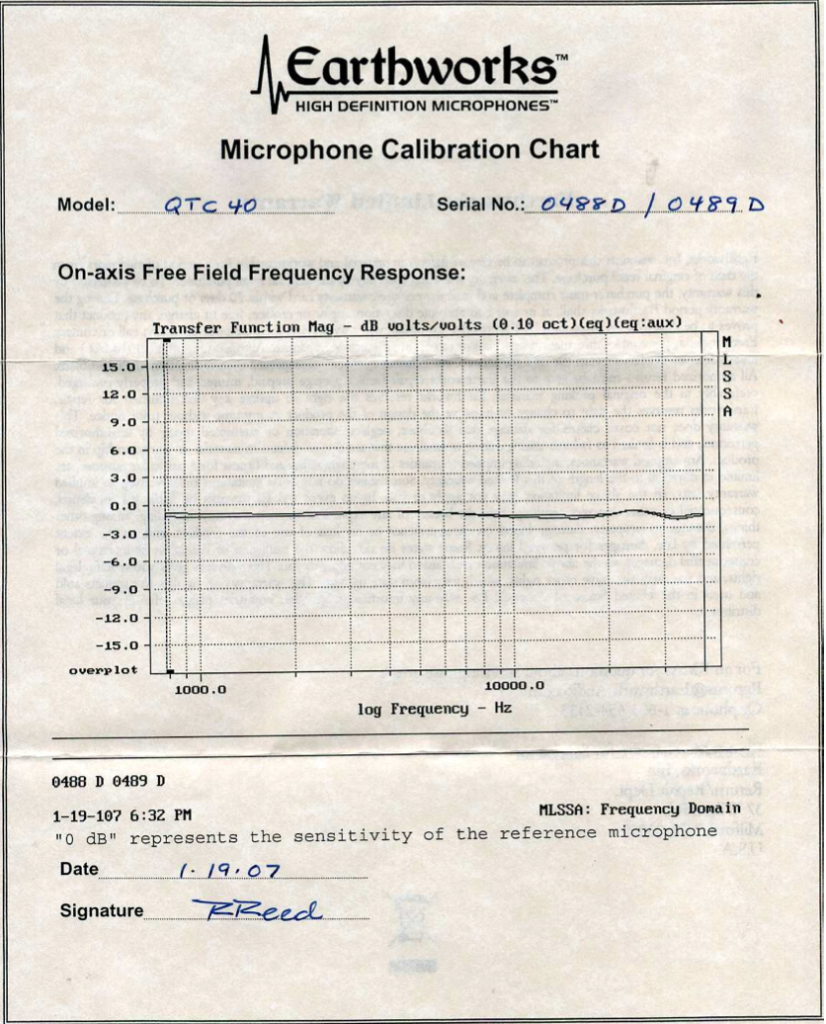HOW TO CHOOSE
Unless you have an unlimited budget, you’ll have to find a balance between cost & quality when selecting an omni measurement mic. Theoretically, the better the mic, the better the measurement.
In reality, if you have the option of loading a calibration file into your software and you can borrow a measurement mic with a known frequency response, you may be able to create a calibration file that compensates for whatever imbalance there is with your mic. Then as long as you manage your rig, your results will be trustworthy and your mic will serve the purpose.
I am spoiled in that I have a good supply of Earthworks omni mics to choose from and so I don’t need to use low end measurement mics but I’ve also been collecting some lessor mics for comparison and for circumstances where I might not want to use an expensive microphone. For example, outdoors where weather may become an issue.
FREQUENCY RESPONSE and IMPULSE RESPONSE
It’s important to have a mic with a known and flat frequency response but frequency response is only one indicator of the quality of a measurement microphone. As important is the microphone’s impulse response. The impulse response of a mic is essentially a view into the time domain of the device which shows how long it takes for the mic to capture a sound, reproduce it at the output & then settle again. In some circles this is called time “smear”. The better the mic, the better the impulse response. Interestingly, if the impulse of a mic is good, the frequency response will also be good.
What does an microphone impulse response look like? The following screen capture is taken from this page on Earthworks website:
Together, the frequency response & impulse response of a microphone dictate how accurately the mic reproduces an electrical signal the present acoustic information.
POLAR RESPONSE
All omni mics are not created equal. This screen capture is taken from this page on Earthworks website:
Polar Response omni microphone comparison
This may seem trivial at first since we aim measurement mics toward the appropriate speaker / speakers but when the goal is to collect accurate phase & frequency response data with a microphone, the microphones off axis response obviously affects the mics ability to pass along off axis information which translates directly to “reflections”.
INDIVIDUAL FREQUENCY RESPONSE CHART
Ideally you want an omni measurement microphone that comes with an individual frequency response chart. A chart that was specifically made for that mic or matched set. Like these. The first image is of a matched pair of Earthworks QTC40 mics. The second image is of another matched pair. Note that the vertical scale is graduated in 3dB increments. All 4 mics are within 1.5dB +/- 1.5dB. A worst case scenario of a 3db difference.
FREQUENCY CALIBRATION FILES
With some measurement applications allowing the user to import a frequency chart directly into the software, you may want to verify that the manufacturer can provide the necessary file .
A CASE AGAINST MEASUREMENT MICROPHONES WITH MISSING OR GENERIC SPECS
Many microphone manufactures provide almost no useful information about their products. Either the typical “Xhz to Xkhz” frequency specification without any indication of what the +/- spec is. For example, “20hz to 20khz”. This could literally mean anything.
The other common ghost frequency response spec is one that offers a single frequency response chart for all microphones of that models. The fact is, every mic is different even if the difference is small. Buying a microphone that doesn’t come with a frequency chart specific to that mic is like buying glasses from a thrift store. What are the chances they were made to correct your vision?
With this said, you’re better off with an inexpensive omni measurement mic than without any measurement mic at all. Once you have a measurement mic, maybe you can measure it against another mic with a known frequency response.
When looking for a measurement mic for critical purposes, you should be focused on flat frequency response and not price. There is no reason to make measurements with a flawed tool. The equivalent of taking pictures with a lens that is dirty. There are industry standard measurement mics made by Earthworks and DPA. This isn’t to say they are the only ones to own but that they are industry standards. There are a bunch of lower cost mics that may or may not be suitable. A good rule of thumb is that if the mic doesn’t come with a frequency response graph for that specific microphone, you can’t know for sure without measuring it against a known mic. Buyer BEWARE!
MATCHED SETS
If you intend to use multiple mics during the measurement process, you should consider buying a set of matched mics. Low cost mics won’t allow for this but the high end varieties will.
Some measurement software such as Smaart allows for importing frequency response data which in theory should make it possible to use different mics from different manufacturers together & still get satisfactory results. Once I know more about how this all works, I’ll post more information.
These mics will come with a mic specific frequency response chart & these companies are known for manufacturing mics.
Earthworks Audio Products – Measurement Series
DPA Microphones – 4007
Schoeps Mikrofone – MK2 omni capsule
Audix – TM1
Beyer – MM1
These mics may or may not include a be perfectly good for basic measurement purposes. Many of them look identical so I guess it’s possible that they are all made in the same factory & re-branded.
Presonus – PRM1
dbx – RTA-M
Nady – CM100
Behringer – ECM8000
Peavey – PVR-2
Here is an interesting shoot out performed by the people at realtraps.com
Realtraps – Microphone Shootout
A note about SPL calibration.
You will need to perform an SPL calibration on your measurement rig if you’re going to know that your SPL meters are accurate in your software app. In order to do this procedure you need what is called a SPL calibrator.
Here is an example of one:



